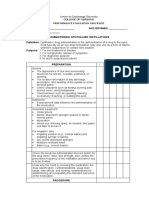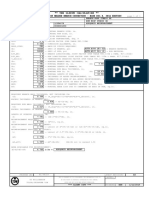Case Study
Case Study
Uploaded by
Jui PeranoCopyright:
Available Formats
Case Study
Case Study
Uploaded by
Jui PeranoCopyright
Available Formats
Share this document
Did you find this document useful?
Is this content inappropriate?
Copyright:
Available Formats
Case Study
Case Study
Uploaded by
Jui PeranoCopyright:
Available Formats
Case Study: Oligohydramnios
Oligohydramnios
Severe reduction of amniotic fluid volume (typically less than 500 ml at term); highly concentrated urine. Possibility of prolonged, dysfunctional labor (usually beginning before term). Fetal risk: renal anomalies, pulmonary hyperplasia, hypoxia, increased skeletal deformities, and wrinkled, leathery skin. Causes Exact cause is unknown. Any condition that prevents the fetus from making urine or that blocks urine from going into the amniotic sac. Contributing factors: uteroplacental insufficiency, premature rupture of membranes prior to labor onset, maternal hypertension, maternal diabetes, intrauterine growth restriction, postterm pregnancy, fetal renal genesis, polycystic kidneys, and urinary tract obstructions. Assessment Asymptomatic Lagging fundal height growth. Test result Ultrasonography reveals no pockets of amniotic fluid larger than 1 cm. Treatment Close medical supervision of the mother and fetus. Fetal monitoring Amnioinfusion (infusion of warmed sterile normal saline or lactated Ringers solution) to treat or prevent variable decelerations during labor. Nursing Interventions 1. 2. 3. 4. 5. Monitor maternal and fetal status closely, including vital signs and fetal heart rate patterns. Monitor maternal weight gain pattern, notifying the health care provider if weight loss occurs. Provide emotional support before, during, and after ultrasonography. Inform the patient about coping measures if fetal anomalies are suspected. Instruct her about signs and symptoms of labor, including those shell need to report immediately.
6. 7. 8. 9.
Reinforce the need for close supervision and follow up. Assist with amnioinfusion as indicated. Encourage the patient to lie on her left side. Ensure that amnioinfusion solution is warmed to body temperature.
10. Continuously monitor maternal vital signs and fetal heart rate during the amnioinfusion procedure. 11. Note the development of any uterine contractions, notify the health care provider, and continue to monitor closely. 12. Maintain amnioinfusion. strict sterile technique during
Oligohydramnios
When a woman has oligohydramnios, the level of amniotic fluid surrounding the baby is too low. To understand how this can affect your health and the health of your baby, it's helpful to first understand the role amniotic fluid plays in a healthy pregnancy. What you need to know about amniotic fluid The amniotic fluid that surrounds your baby plays an important role in your baby's growth and development. This clear-colored liquid protects the baby and provides it with fluids. Your baby breathes this fluid into its lungs and swallows it. This helps your baby's lungs and digestive system grow strong. Your amniotic fluid also allows the baby to move around, which helps it to develop its muscles and bones. The amniotic sac that contains your baby begins to form about 12 days after conception. Amniotic fluid begins to form at that time, too. In the early weeks of pregnancy, amniotic fluid is mainly made up of water supplied by the mother. After about 20 weeks, your baby's urine makes up most of the fluid. The amount of amniotic fluid increases until about 36 weeks of pregnancy. At that time you have about 1 quart of fluid. After that time, the level begins to decrease. What you need to know about oligohydramnios Oligohydramnios (too little amniotic fluid) occurs in
about 4 out of every 100 pregnancies. It is most common in the last trimester of pregnancy, but it can develop at any time in the pregnancy. About 1 out of 8 women whose pregnancies last 2 weeks past the due date develops oligohydramnios. This happens as amniotic fluid levels naturally decline. Oligohydramnios is diagnosed with ultrasound. The causes of this condition are not completely understood. Some pregnant women who develop oligohydramnios never know the cause. Some causes are: Certain birth defects in the baby Ruptured membranes (breaks or tears in the sac that holds the amniotic fluid) A pregnancy that goes 2 weeks past the due date A health condition in the pregnant woman, such as high blood pressure, diabetes or lupus Birth defects involving the kidneys and urinary tract can cause this problem. That's because babies with these birth defects produce less urine, which makes up most of the amniotic fluid. Oligohydramnios may affect you, your baby, and your labor and delivery in different ways. The effects depend on the cause, when the problem occurs, and how little fluid there is. In the first two trimesters, too little amniotic fluid may result in birth defects of the lungs and limbs. During this period, oligohydramnios increases the risk of miscarriage, preterm birth and stillbirth. When oligohydramnios occurs in the third trimester, it is linked to poor fetal growth, complications during labor and birth, and increased risk of cesarean section. Women with otherwise normal pregnancies who develop oligohydramnios near their due date probably need no treatment. Their babies are likely to be born healthy. Even so, your provider may want to watch you closely. When treatment is needed, the amniotic fluid may need to be replaced with an artificial substitute. What you can do The best thing you can do is to go to all your prenatal care appointments. Your health care provider can monitor the size of your belly and how much amniotic fluid is in your womb. If you have a
problem, your provider can take steps to help prevent complications in you and your baby. Women with high blood pressure, diabetes and lupus are at increased risk for oligohydramnios. If you have any of these conditions, be sure to let your health care provider know. If you have high blood pressure: Talk to your health care provider before pregnancy (or as soon as you think you are pregnant). Be sure any medications you are taking are safe during pregnancy Be sure your blood pressure is well controlled. If you have oligohydramnios, be sure to eat a healthy and nutritious diet, drink lots of fluids (water is best), get plenty of rest, avoid smoking, and report any signs of preterm labor to your health care provider right away.
MAS can happen before, during, or after labor and delivery when a newborn inhales (or aspirates) a mixture of meconium and amniotic fluid (the fluid in which the baby floats inside the amniotic sac). Meconium is the baby's first feces, or poop, which is sticky, thick, and dark green and is typically passed in the womb during early pregnancy and again in the first few days after birth. The inhaled meconium can partially or completely block the baby's airways. Although air can flow past the meconium trapped in the baby's airways as the baby breathes in, the meconium becomes trapped in the airways when the baby breathes out. And so, the inhaled meconium irritates the baby's airways and makes it difficult to breathe. MAS can affect the baby's breathing in a number of ways, including chemical irritation to the lung tissue, airway obstruction by a meconium plug, infection, and the inactivation of surfactant by the meconium (surfactant is a natural substance that helps the lungs expand properly). The severity of MAS depends on the amount of meconium the baby inhales as well as underlying conditions, such as infections within the uterus or postmaturity (when a baby is overdue, or more than 40 weeks' gestational age). Generally, the more meconium a baby inhales, the more serious the condition. Normally, fluid is moved in and out of only the trachea (the upper portion of the airway) when there's breathing activity in the fetus. Meconium can be inhaled into the lungs when the baby gasps while still in the womb or during the initial gasping breaths after delivery. This gasping typically happens when there has been a problem (i.e., an infection or compression of the umbilical cord) that causes the baby to have difficulty getting enough oxygen in the womb. Causes MAS is often related to fetal stress. Fetal stress can be caused by problems in the womb, such as infections, or by difficulties during the labor process. A distressed baby may experience hypoxia (decreased oxygen), which may make the baby's
intestinal activity increase and may cause relaxation of the anal sphincter (the muscular valve that controls the passage of feces out of the anus). This relaxation then moves meconium into the amniotic fluid that envelops the baby. But meconium passage during labor and delivery isn't always associated with fetal distress. Occasionally, babies who aren't distressed during the birth process pass meconium before birth. In either case, a baby that gasps or inhales meconium can develop MAS. Additional risk factors for MAS include: a difficult delivery advanced gestational age (or postmaturity) a mother who smokes cigarettes heavily or who has diabetes,high blood pressure (hypertension), or chronic respiratory or cardiovascular disease umbilical cord complications poor intrauterine growth (poor growth of the baby while in the uterus) Prematurity is not a risk factor. In fact, MAS is rare in babies born before 34 weeks. Signs and Symptoms At birth, the doctor will likely notice one or more symptoms of MAS, including: meconium or dark green streaks or stains in the amniotic fluid discoloration of the baby's skin either blue (cyanosis) or green (from being stained by the meconium) problems with breathing including rapid breathing (tachypnea), labored (difficulty) breathing, or suspension of breathing (apnea) low heart rate in the baby before birth low Apgar score (the Apgar test is given to newborns just after birth to quickly evaluate color, heartbeat, reflexes, muscle tone, and breathing) limpness in the baby postmaturity (signs that a baby is overdue such as long nails)
Diagnosis
If a baby is thought to have inhaled meconium, treatment will begin during delivery. If the baby has any depression in breathing, the doctor taking care of the baby will insert a laryngoscope into the babys trachea to remove any meconium that might be present. The doctor will also probably listen to the baby's chest with a stethoscope for sounds in the lungs that are common in infants with MAS. The doctor may also order tests a blood test (called a blood gas analysis) that helps determine if the baby is getting enough oxygen and a chest X-ray that can show patches or streaks on the lungs that are found in babies with MAS. Babies with MAS may be sent to a special care nursery or aneonatal intensive care unit (NICU) to be closely monitored for the next few days. Treatments may include: oxygen therapy by oxygen hood or ventilation antibiotics use of surfactant nitric oxide obtaining blood routinely to determine if the baby is receiving enough oxygen Severe Aspiration Babies who have severe aspiration and require mechanical ventilation are at increased risk for bronchopulmonary dysplasia, a lung condition that can be treated with medication or oxygen. Another complication associated with MAS is a collapsed lung. Also known as pneumothorax, a collapsed lung is treated by reinflating the lung (inserting a tube between the ribs, allowing the lung to gradually re-expand). Although rare, a small percentage of babies with severe MAS develop aspiration pneumonia. If this occurs, the doctor may recommend advanced lung rescue therapy. Three therapies are currently used to treat aspiration pneumonia and severe forms of MAS:
1.
2.
3.
Surfactant therapy: An artificial surfactant is instilled into the baby's lungs, which helps to keep the air sacs open. High-frequency oscillation: This special ventilator vibrates air enriched with extra oxygen into the baby's lungs. Rescue therapy: Nitric oxide is added to the oxygen in the ventilator. It dilates the blood vessels and allows more blood flow and oxygen to reach the baby's lungs.
If one of these therapies (or a combination of them) doesn't work, there is another alternative. Extra corporeal membrane oxygenation (ECMO) is a form of cardiopulmonary bypass, meaning that an artificial heart and lung will temporarily take over to supply bloodflow to the baby's body. ECMO reduces the fatality rate for these severely distressed infants from 80% to 10%. Not all hospitals are ECMO centers, so babies that require ECMO might need to be moved to another hospital. Babies with severe cases of MAS may come home from the hospital on oxygen. They may be more likely to have wheezing and lung infections during their first year, but lungs can regenerate new air sacs, so the long-term prognosis for their lungs is excellent. Possible Long-Term Complications Severely affected babies are at risk for developing chronic lung disease and may also have developmental abnormalities and hearing loss. Babies diagnosed with MAS will be screened at the hospital for hearing problems or neurological damage. Although very rare, severe cases of MAS may be fatal. Studies have indicated that deaths from MAS have decreased significantly through interventions such as suctioning and reducing the number of postterm births. Prevention It's important for a pregnant woman to tell her doctor immediately if meconium is present in the amniotic fluid when her water breaks, or if the fluid has dark green stains or streaks. Doctors also use a
fetal monitor during labor to observe the baby's heart rate for any signs of fetal distress. In some cases doctors may recommend amnioinfusion, the dilution of the amniotic fluid with saline, to wash meconium out of the amniotic sac before the baby has a chance to inhale it at birth. Although MAS is a frightening complication for parents to face during the birth of their child, the majority of cases are notsevere. Most infants are monitored for fetal distress during labor, and doctors pay careful attention to any signs that would indicate meconium aspiration. If it does occur, treatment will begin immediately. For most infants who have inhaled meconium, early treatment can prevent further complications and help to reassure anxious new parents.
You might also like
- Labor-Vaginal Delivery Anne Jones, 17 Years Old Case Study With Complete Solutions 2023Document13 pagesLabor-Vaginal Delivery Anne Jones, 17 Years Old Case Study With Complete Solutions 2023CHARLES MAINANo ratings yet
- Maternal and Child Nursing - Intrapartum PeriodDocument91 pagesMaternal and Child Nursing - Intrapartum Periodchuppepay20% (5)
- BC Live Project ReportDocument13 pagesBC Live Project ReportRishabh SinghNo ratings yet
- Procurement Plan TemplateDocument17 pagesProcurement Plan TemplateCivil Kittie100% (1)
- Sap Charm: (Solution Manager 7.2)Document17 pagesSap Charm: (Solution Manager 7.2)Krishna Vamshi50% (2)
- Polyhydramnios (Revised)Document34 pagesPolyhydramnios (Revised)Edward Munyaradzi KutsanziraNo ratings yet
- Complications of PuerperiumDocument20 pagesComplications of Puerperiumrevathidadam55555No ratings yet
- 10 Nurses Proper Professional EtiquetteDocument1 page10 Nurses Proper Professional EtiquetteReva stevanaNo ratings yet
- Purpose of The LaryngosDocument13 pagesPurpose of The LaryngosdessriyaNo ratings yet
- A Nursing Care Plan On OligohydramniosDocument7 pagesA Nursing Care Plan On OligohydramniosTintin Honra100% (1)
- Complication & Minor Ailments of PuerperiumDocument61 pagesComplication & Minor Ailments of PuerperiumMohammed AbdNo ratings yet
- NCP2 - Active PhaseDocument14 pagesNCP2 - Active PhasepriyankaNo ratings yet
- Omphalitis LectureDocument18 pagesOmphalitis LectureWonyenghitari George0% (1)
- RZ - SGH Ok Polyhydramnios and OligohydramniosDocument24 pagesRZ - SGH Ok Polyhydramnios and OligohydramniosBilly DarismaNo ratings yet
- Drugs Used in PregnancyDocument11 pagesDrugs Used in PregnancyTasmia RhamanNo ratings yet
- Pregnancy Induced Hypertension Case StudyDocument77 pagesPregnancy Induced Hypertension Case StudyATEHAN BORDS100% (1)
- Compound PresentationDocument10 pagesCompound PresentationmaezuNo ratings yet
- Psychological Perspective of Abnormal LaborDocument25 pagesPsychological Perspective of Abnormal LaborPriscilla Sarah PayneNo ratings yet
- Checklist Administering Ophthalmic InstillationsDocument5 pagesChecklist Administering Ophthalmic InstillationsJanna LacastesantosNo ratings yet
- Barium SwallowDocument2 pagesBarium SwallowmameenNo ratings yet
- Antenatal Palpation.: Carole BakerDocument20 pagesAntenatal Palpation.: Carole Bakeragupag1No ratings yet
- ANTENATAL CARE Translate GooglingDocument26 pagesANTENATAL CARE Translate GooglingLutfi ari206100% (2)
- Abruptio PlacentaDocument5 pagesAbruptio PlacentaJuan Carlo Z. SolidumNo ratings yet
- NVD With EpisiotomyDocument4 pagesNVD With EpisiotomySimran SimzNo ratings yet
- Case StudyDocument7 pagesCase Studymark kennethNo ratings yet
- Cs On TefDocument10 pagesCs On TefArchana SahuNo ratings yet
- PPROMDocument63 pagesPPROMSaraMohammedNo ratings yet
- PNC Case Study On Perineal Tear PDFDocument32 pagesPNC Case Study On Perineal Tear PDFRanjita GaudNo ratings yet
- Report of PPHDocument58 pagesReport of PPHNishaThakuriNo ratings yet
- Nunguni Sub County ExperinceDocument19 pagesNunguni Sub County Experincearthurtruthmburu100% (1)
- Amnio ReductionDocument5 pagesAmnio ReductionNovhy Ganggut100% (1)
- NCP PPHDocument2 pagesNCP PPHMark Joseph Christian100% (1)
- Care Plan Presentation On Meningitis PatientDocument20 pagesCare Plan Presentation On Meningitis PatientDuop Jock LiemNo ratings yet
- Health Problems MyselfDocument54 pagesHealth Problems MyselfKrishnaveni Murugesh100% (2)
- Episiotomy & Laceration: Divina Gracia Vibal Cielo Bsm-1Document36 pagesEpisiotomy & Laceration: Divina Gracia Vibal Cielo Bsm-1Divina Gracia Vibal CieloNo ratings yet
- Respiratory Distress SyndromeDocument121 pagesRespiratory Distress Syndromeinno so qtNo ratings yet
- Care PlanDocument4 pagesCare PlangopscharanNo ratings yet
- NSVDDocument48 pagesNSVDchiqui14100% (2)
- Antenatal CareDocument82 pagesAntenatal Caremdasad18No ratings yet
- Case StudyDocument5 pagesCase StudyKezya SaludesNo ratings yet
- Tocolytic DrugDocument11 pagesTocolytic DrugWan Ahmad FaizFaizalNo ratings yet
- Final Case Study SLDocument17 pagesFinal Case Study SLCharmie Mei Paredes-RoqueNo ratings yet
- Neonatal Jaundice: ObjectivesDocument12 pagesNeonatal Jaundice: ObjectivesMadx VNo ratings yet
- Abortionsource 100605123737 Phpapp01Document38 pagesAbortionsource 100605123737 Phpapp01Erina Erichan OtoNo ratings yet
- 51 EpisiotomyDocument21 pages51 Episiotomydr_asaleh100% (2)
- Bag TechniqueDocument12 pagesBag TechniquePerlie Loren Arreo CabatinganNo ratings yet
- Clinical Lesson PlanDocument22 pagesClinical Lesson PlanShilpa JoshiNo ratings yet
- OLIGOHYDRAMNIOSDocument27 pagesOLIGOHYDRAMNIOSSimi SaiPrasoonNo ratings yet
- Post Partum Haemorrhage-1Document29 pagesPost Partum Haemorrhage-1medical chroniclesNo ratings yet
- SIM - Anemias of PregnancyDocument17 pagesSIM - Anemias of PregnancyGabrielle EvangelistaNo ratings yet
- Fetal Distress Case DiscussionDocument55 pagesFetal Distress Case DiscussionHafsah G.No ratings yet
- HIV in Mothers and ChildrenDocument90 pagesHIV in Mothers and Childrenabubaker100% (1)
- CoughDocument2 pagesCoughBheru LalNo ratings yet
- Abnormal PuerperiumDocument21 pagesAbnormal PuerperiumNatukunda DianahNo ratings yet
- Common Neonatal DisordersDocument27 pagesCommon Neonatal DisordersLaishram Deeva ChanuNo ratings yet
- Indigenoussystemofmedicine 190329102338Document27 pagesIndigenoussystemofmedicine 190329102338Shilu Mathai PappachanNo ratings yet
- 19 Myths and Misconceptions About FP - 0Document3 pages19 Myths and Misconceptions About FP - 0iammerbinpransisko100% (1)
- Discharge Planning Bleeding Peptic Ulcer DiseaseDocument5 pagesDischarge Planning Bleeding Peptic Ulcer DiseaseAlexandrea MayNo ratings yet
- WHO Labour Care GuideDocument34 pagesWHO Labour Care GuideAnkita Singh100% (1)
- Case Study - GDMDocument5 pagesCase Study - GDMRomeo ReyesNo ratings yet
- Ventricular Septal Defect, A Simple Guide To The Condition, Treatment And Related ConditionsFrom EverandVentricular Septal Defect, A Simple Guide To The Condition, Treatment And Related ConditionsNo ratings yet
- Role of Dietary Fibers and Nutraceuticals in Preventing DiseasesFrom EverandRole of Dietary Fibers and Nutraceuticals in Preventing DiseasesRating: 5 out of 5 stars5/5 (1)
- The Ride of Your Life: What I Learned about God, Love, and Adventure by Teaching My Son to Ride a BikeFrom EverandThe Ride of Your Life: What I Learned about God, Love, and Adventure by Teaching My Son to Ride a BikeRating: 4.5 out of 5 stars4.5/5 (2)
- J&T ExpressDocument1 pageJ&T ExpressDiane SaibonNo ratings yet
- Biology: Books & PublicationsDocument15 pagesBiology: Books & PublicationsMuntaha IjazNo ratings yet
- MKTG Analytics-Final ProjectDocument46 pagesMKTG Analytics-Final Projectapi-728810138No ratings yet
- The Descriptor Differential Scale of Pain Intensity: An Evaluation of Item and Scale PropertiesDocument10 pagesThe Descriptor Differential Scale of Pain Intensity: An Evaluation of Item and Scale PropertiesOlavo BrilhanteNo ratings yet
- CBSE Class 9 English Drama Villa For SaleDocument17 pagesCBSE Class 9 English Drama Villa For SaleDreamy YTNo ratings yet
- Gebräuchliche Arzneimittel in Der Praxis, 3. Auflage-Springer, Wien (2011) - PDFDocument585 pagesGebräuchliche Arzneimittel in Der Praxis, 3. Auflage-Springer, Wien (2011) - PDFesmiracelilova42No ratings yet
- 4 BoardCompanion BiologyDocument58 pages4 BoardCompanion BiologyEntirety 4uNo ratings yet
- ADHD Coaching-A Practical GuideDocument5 pagesADHD Coaching-A Practical GuideMariano Navarro-Rubio TroisfontainesNo ratings yet
- Joseph GuidelinesDocument3 pagesJoseph GuidelinesRogue31179No ratings yet
- Mid Term Exam Class-X Subject-Social Science SESSION 2020-21 Set-A Answer The Following QuestionsDocument5 pagesMid Term Exam Class-X Subject-Social Science SESSION 2020-21 Set-A Answer The Following QuestionsAnishikaNo ratings yet
- Cable Routing Management: An AVEVA Business PaperDocument8 pagesCable Routing Management: An AVEVA Business PaperBakri IsmailNo ratings yet
- BRKRST 2377Document98 pagesBRKRST 2377bienth89No ratings yet
- Cimco HSMUser Guide A5 WebDocument77 pagesCimco HSMUser Guide A5 WebBartosz SieniekNo ratings yet
- Coping With Anxiety WorkbookDocument32 pagesCoping With Anxiety Workbookfranchfi75% (4)
- TDW Sleeve Calculation : Reinforcement of Welded Branch Connection - Asme B31.8, 2016 EditionDocument1 pageTDW Sleeve Calculation : Reinforcement of Welded Branch Connection - Asme B31.8, 2016 EditionCristhian-Israel RodriguezNo ratings yet
- Study Centre WbcrosDocument85 pagesStudy Centre WbcrosJashaikati High School100% (1)
- RC60 - 72H Kubota 60" Deck Parts BookDocument17 pagesRC60 - 72H Kubota 60" Deck Parts Bookbrja73gmailNo ratings yet
- Alternative Stimulasi Kemampuan Kognitif Melalui Penerapan Model Pembelajaran Berbasis Permainan KomprehensifDocument8 pagesAlternative Stimulasi Kemampuan Kognitif Melalui Penerapan Model Pembelajaran Berbasis Permainan KomprehensifLintang Ati SafitriNo ratings yet
- IslamDocument5 pagesIslamMohammad EssamNo ratings yet
- What Is The Assessment Based National Dialogue (ABND) and How It WorksDocument30 pagesWhat Is The Assessment Based National Dialogue (ABND) and How It WorksAdithyaNo ratings yet
- Multiple IntelligencesDocument2 pagesMultiple IntelligencesNtsako BaloyiNo ratings yet
- Dining Area PreparationDocument8 pagesDining Area Preparationehm-ar. SilvaNo ratings yet
- Deep Vein ThrombosisDocument4 pagesDeep Vein ThrombosisAgatha FeliciaNo ratings yet
- Connotation (Or "Extended/symbolic Meaning"), of Many of The Ideas Being Expressed, FromDocument14 pagesConnotation (Or "Extended/symbolic Meaning"), of Many of The Ideas Being Expressed, FromLivanur ErbilNo ratings yet
- Write On Care and Maintenance of FabricsDocument8 pagesWrite On Care and Maintenance of FabricsmadhugangulaNo ratings yet
- HRM2601Document5 pagesHRM2601Andre De BeerNo ratings yet
- An Anatomy of LonelinessDocument4 pagesAn Anatomy of LonelinessTheodore LiwonganNo ratings yet

























































































